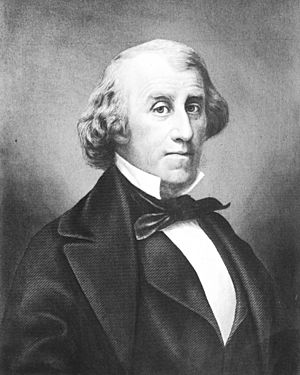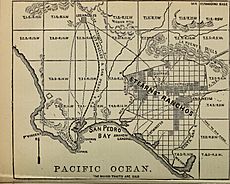Abel Stearns facts for kids
Quick facts for kids
Abel Stearns
|
|
|---|---|
 |
|
| Born | February 9, 1798 |
| Died | August 23, 1871 (aged 73) San Francisco, California, U.S.
|
| Nationality | American, Mexican |
| Occupation | Entrepreneur, Rancher |
| Known for | Early California pioneer |
| Spouse(s) | Arcadia Bandini |
Abel Stearns (February 9, 1798 – August 23, 1871) was an important trader and businessman in early California. He moved to the Pueblo de Los Angeles in 1829. He became a very wealthy landowner and cattle rancher. He was one of the richest people in the area.
Contents
Early Life and Move to California
Abel Stearns was born in Lunenburg, Massachusetts, in 1798. His parents, Elizabeth and Levi Stearns, were farmers. Their families had come from England in the 1600s.
Around 1826, Stearns moved to Mexico. He became a citizen of Mexico there.
Life in Los Angeles
In 1829, Stearns moved to Monterey, California. Soon after, he settled in the Pueblo de los Ángeles, which is now Los Angeles, California.
He got permission from the government to build a large warehouse. This warehouse was at San Pedro, the closest seaport. Later, he created a stagecoach route. This route connected San Pedro Bay with the Los Angeles pueblo. In 1831, he built a three-story flour mill in Los Angeles. Stearns quickly became one of the most important people in the pueblo.
Ranchos and Challenges
In 1842, Stearns bought his first large ranch, called Rancho Los Alamitos. This ranch was about 28,000 acres. It was located between Los Angeles and the harbor.
A severe drought happened between 1862 and 1864. This drought caused many cattle to die. It is said that 50,000 cattle on Stearns' land alone died. Because of this, Stearns had to mortgage his rancho. He eventually lost it when the mortgage was bought by someone else.
Gold and Public Service
In 1842, Abel Stearns made the first recorded shipment of California gold to the U.S. Mint. On July 8, 1843, he sent 1,843 ounces of placer gold. This gold was worth $19 an ounce at the time. It was deposited at the Philadelphia Mint.
After the Mexican–American War, Stearns played a role in politics. He represented Los Angeles to the U.S. military government of California from 1848 to 1850. He was also a delegate to the 1849 California Constitutional Convention. This convention helped create California's first constitution. Later, he served as a member of the California State Assembly. He was also a Los Angeles County Supervisor. He was a member of the Los Angeles Common Council, which was the city government.
Abel Stearns' Ranchos
By 1860, Stearns was the biggest landowner in Southern California. He owned many large ranches. These included Rancho La Habra, Rancho Los Coyotes, Rancho San Juan Cajón de Santa Ana, Rancho Las Bolsas, Rancho La Bolsa Chica, Rancho Jurupa, and Rancho La Sierra.
The drought of 1863–64 hit Stearns very hard. He lost thousands of cattle. By 1868, he had serious money problems. He had to mortgage almost all of his ranch properties.
The Robinson Trust
To get money to keep his businesses going, Stearns started a new partnership. This was a real estate sales group with Alfred Robinson and four investors from San Francisco. This group was called the Robinson Trust, formed in 1868.
Stearns gave about 177,796 acres of land to the Trust. This included almost all of his ranchos. The time of very large cattle ranches was ending. Instead, people wanted to grow crops. So, the large ranches were divided into smaller farms. The Robinson Trust helped sell these smaller pieces of land. They worked with the California Immigrant Union to help with sales.
Even though Stearns and the other members of the Trust sometimes disagreed, the Robinson Trust was successful. By 1870, Stearns had paid off his debts from the drought. He was starting to build his wealth again.
Family Life
Abel Stearns was sometimes called "Cara de Caballo" (Horse Face). This was because of his long face. In 1841, he married Arcadia Bandini. She came from the wealthy Bandini family. They lived and entertained guests at their home in Los Angeles, known as the historic Don Abel Stearns House.
Abel Stearns passed away on August 23, 1871, at the age of 72. He died in San Francisco, California. He is buried at Calvary Cemetery in Los Angeles.
See Also


